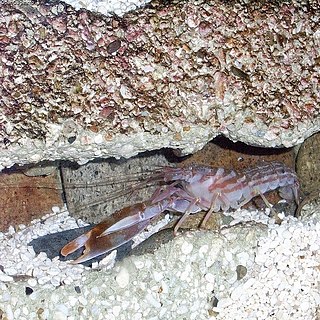
The family Polychelidae contains thirty-eight extant species of blind, benthic lobster-like crustaceans. They are found throughout the world's tropical, sub-tropical and temperate oceans, including the Mediterranean Sea and the Irish Sea.

Hippolytidae is a family of cleaner shrimp, also known as broken-back shrimp or anemone shrimp. The term "broken-back shrimp" also applies to the genus Hippolyte in particular and "cleaner shrimp" is sometimes applied exclusively to Lysmata amboinensis.

The Hyperiidea are a suborder of amphipods, small aquatic crustaceans. Unlike the other suborders of Amphipoda, hyperiids are exclusively marine and do not occur in fresh water. Hyperiids are distinguished by their large eyes and planktonic habitat. Most species of hyperiids are parasites or predators of salps and jellyfish in the plankton, although Themisto gaudichaudii and a few relatives are free-swimming predators of copepods and other small planktonic animals.

Alpheus is a genus of snapping shrimp of the family Alpheidae. This genus contains in excess of 330 species, making this the most species-rich genus of shrimp. Like other snapping shrimp, the claws of Alpheus are asymmetrical, with one of the claws enlarged for making a popping noise. Some species in the genus enter into symbiotic relationships with gobiid fishes, and others associate with sea anemones.

Polycheles typhlops is a species of blind, deep water decapod crustacean with a cosmopolitan distribution. It is "one of the dominant and most characteristic crustaceans in deep-sea communities of the Mediterranean Sea".

Benthesicymus is a genus of prawns, containing the following species:

Macrobrachium is a genus of freshwater prawns or shrimps characterised by the extreme enlargement of the second pair of pereiopods, at least in the male.

Hymenopenaeus is a genus of prawns containing 17 species.

Acanthephyra is a genus of shrimp in the family Acanthephyridae, with species that live at depths from 0 to more than 5000 meters deep below the ocean surface.
Odius is a genus of amphipods belonging to the family Ochlesidae.
Gammaracanthus is a genus of crustaceans belonging to the monotypic family Gammaracanthidae.
Campylonotus is a genus of crustaceans belonging to the monotypic family Campylonotidae.
Apherusa is a genus of amphipods belonging to the family Calliopiidae.

Hadropenaeus is a genus of prawns within the family Solenoceridae. Members of this genus are found at depths up to 1280 meters.

Pandalus lucidirimicola, the sparkling shrimp, is a species of caridean shrimp in the family Pandalidae.

Aristeus is a genus of dendrobranchiate decapod crustaceans. Some species are subject to commercial fisheries.

Pentacheles is a genus of crustaceans of the class Malacostraca.

Cheiroplatea is a genus of hermit crabs within the family Pylochelidae.

Pleoticus is a genus of decapods within the family Solenoceridae. Members of this genus are distributed in marine waters 12 to 2060 meters below sea level.















